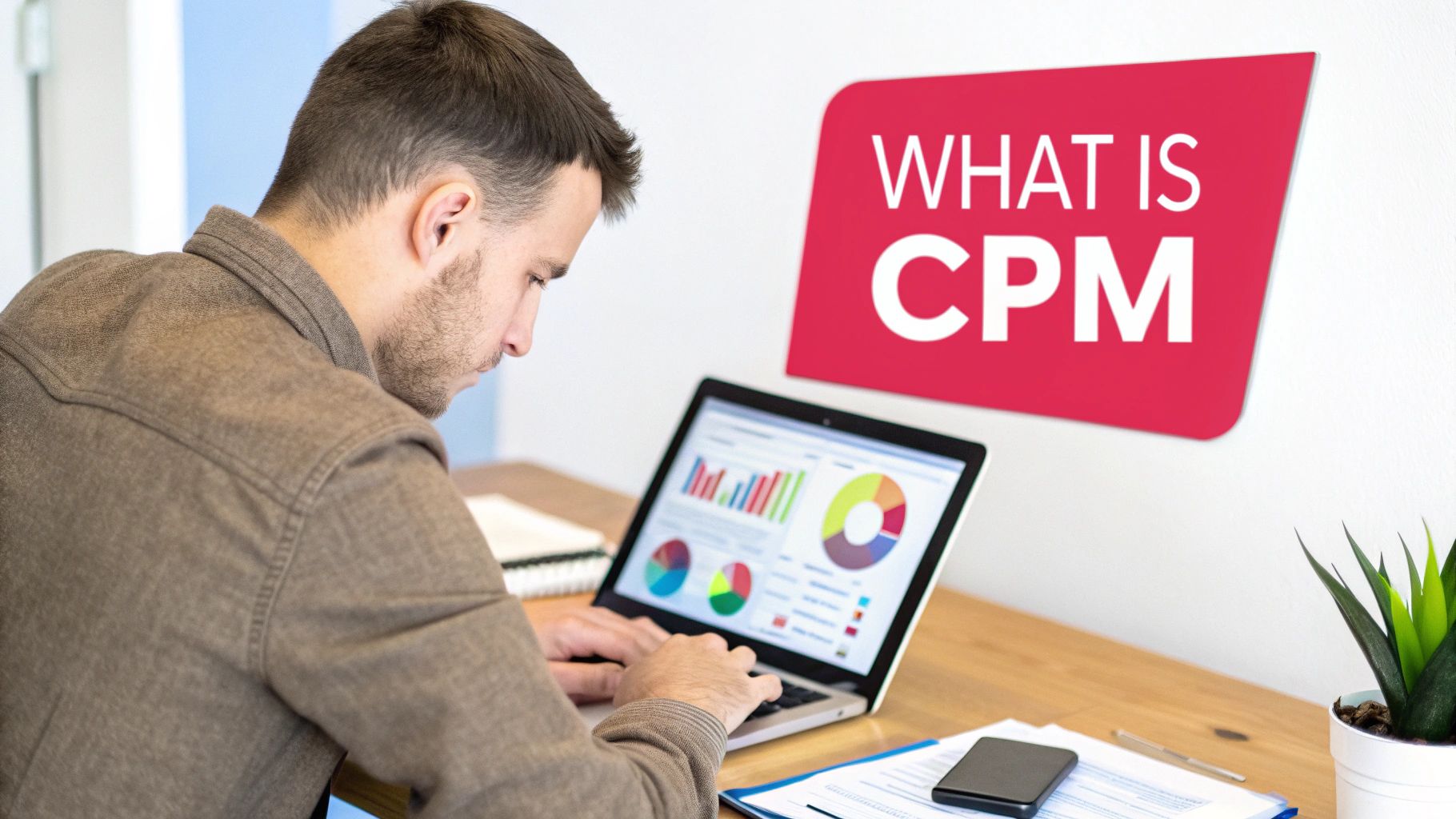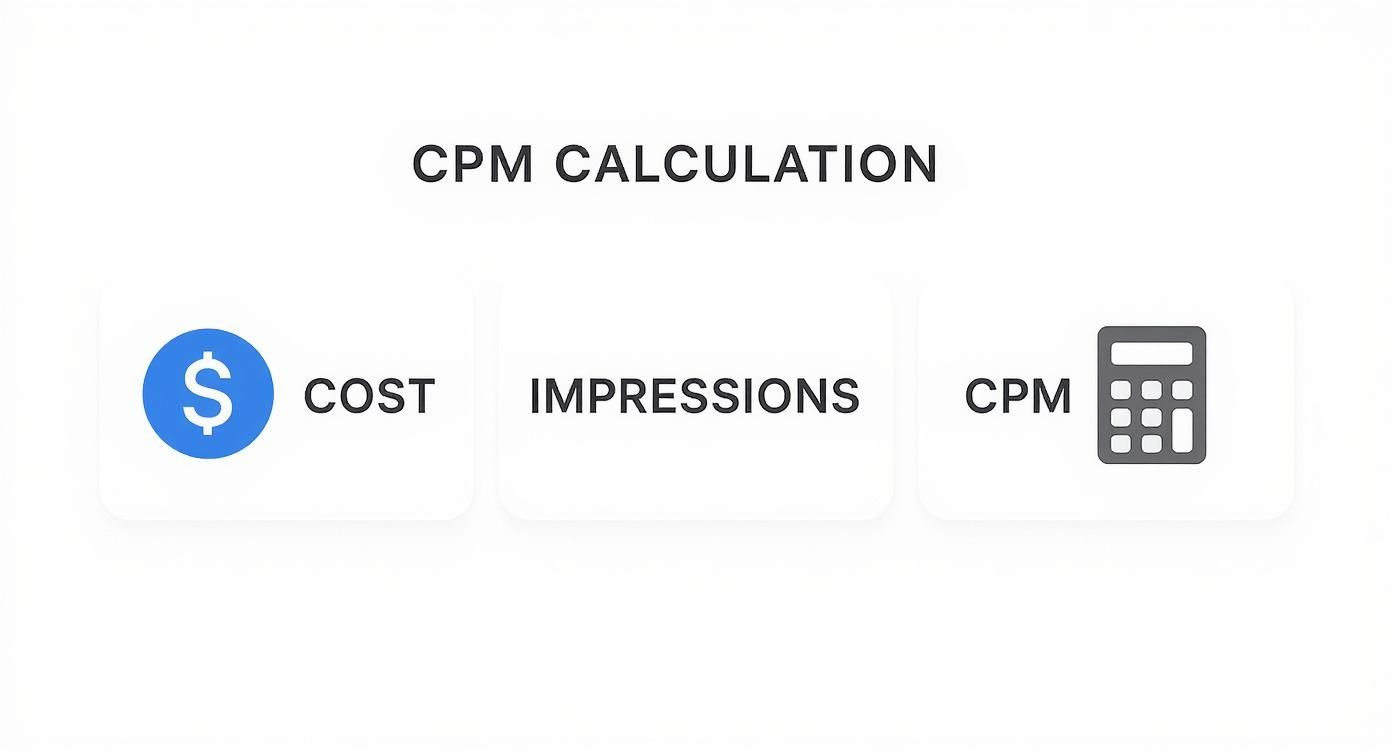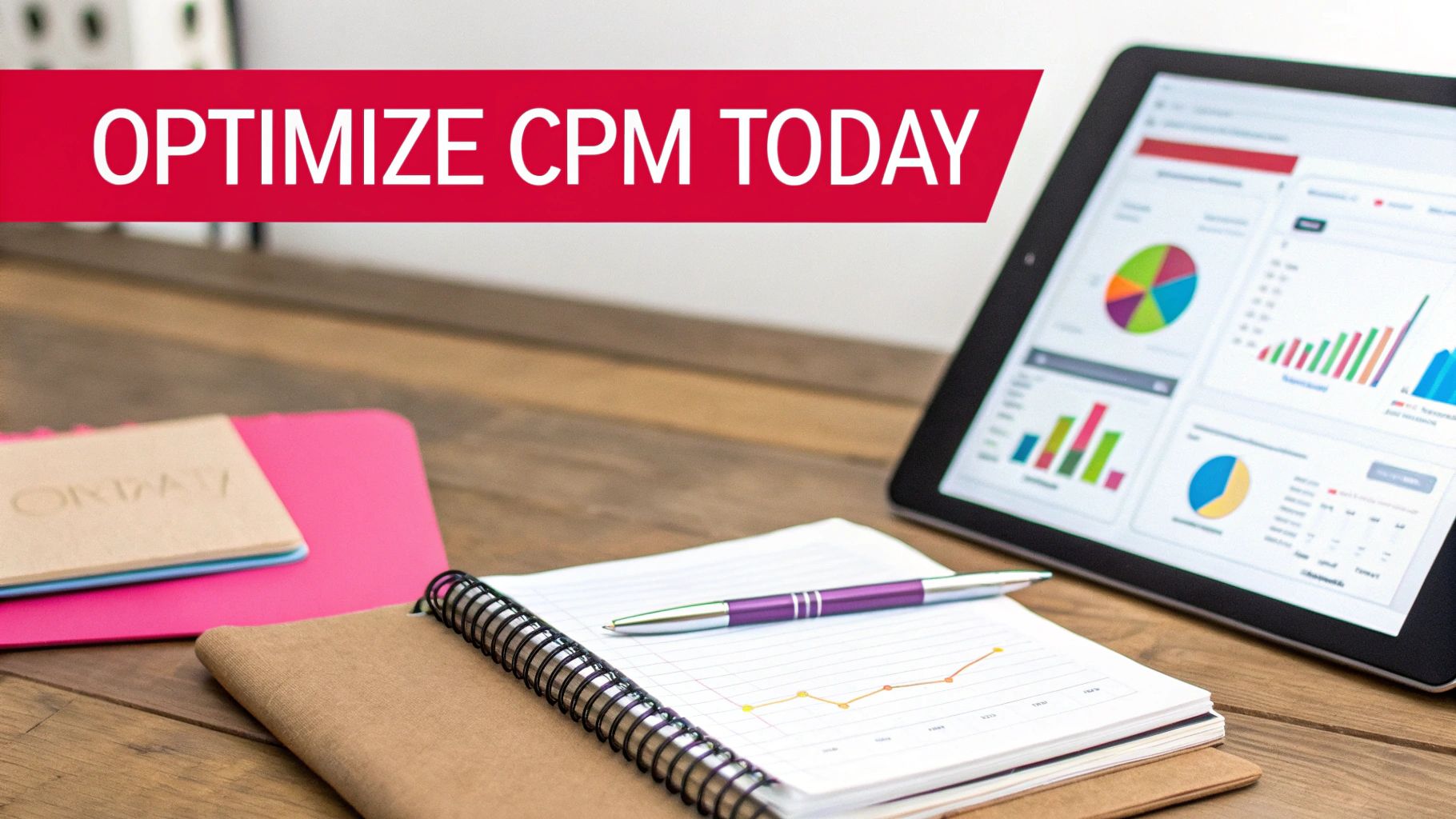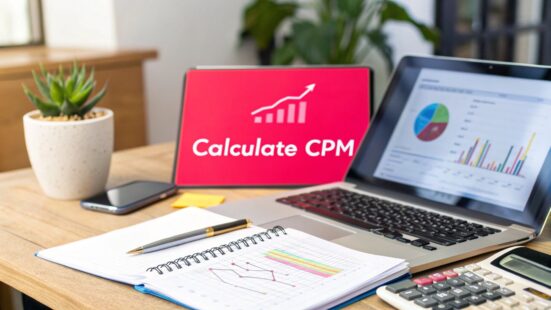 7 Influencer Marketing Examples to Boost Your 2025 Strategy
7 Influencer Marketing Examples to Boost Your 2025 Strategy
At its core, calculating CPM (Cost Per Mille) tells you what you pay for one thousand ad impressions. It's a fundamental metric, especially when you're focused on getting your brand name out there. Nailing this simple calculation is the first step toward smarter media buying and stretching your budget further.
Table of Contents
Why Understanding CPM Matters For Your Campaigns

Think of CPM as a quick health check for your campaign planning. It gives you a standard way to compare ad costs across different platforms, whether you're running ads on Meta, TikTok, or the Google Display Network. For anyone in DTC or e-commerce, this metric is a must-know because it ties your reach directly to your spending.
But here’s a common trap: thinking a lower CPM is always the goal. While being cost-effective is great, the quality of those impressions matters way more. A rock-bottom CPM might just mean your ads are being shown to the wrong audience or on sketchy websites, which is just wasted cash. The real win is finding that sweet spot between cost and high-quality eyeballs.
CPM In The Broader Marketing Context
To really get a handle on CPM, it helps to see where it fits in with other key advertising metrics. Each one has a different job to do in your overall strategy. Here’s a quick rundown of the main players to help you see the bigger picture.
Key Advertising Metrics at a Glance
| Metric | What It Measures | Best Used For |
|---|---|---|
| CPM | Cost for every 1,000 impressions. | Brand awareness and maximizing visibility. |
| CPC | Cost every time someone clicks your ad. | Driving website traffic and immediate engagement. |
| CPA | Cost to get a specific action (like a sale or lead). | Performance-based goals and direct conversions. |
This distinction is crucial. While CPC and CPA are your go-to metrics for driving actions, CPM is all about gauging how efficiently you're capturing attention.
Many of the most successful strategies I've seen blend these models. For instance, you could kick off a campaign with a CPM focus to build broad awareness, then retarget the people who showed interest with a CPC or CPA campaign to drive sales. This kind of integrated approach is a core part of https://joinbrands.com/blog/what-is-performance-marketing/.
The CPM Formula And Where It Came From
The formula itself is refreshingly simple:
CPM = (Total Campaign Cost / Total Impressions) × 1,000
So, if you spend $6,000 on a campaign that gets 1 million impressions, your CPM works out to be $6.00.
This metric has been around for ages, long before digital ads took over, because it provides a standardized way to compare costs across any media channel. Its simplicity and comparability are what made it a staple in the digital world we operate in today.
Ultimately, CPM is a fundamental metric for understanding the cost-efficiency of various paid advertising campaigns. Getting comfortable with its calculation and what it truly means is non-negotiable for any marketer looking to make informed decisions, optimize their budget, and drive better results.
How to Actually Calculate Your CPM
The math for figuring out your CPM is pretty simple. The real first step is knowing where to dig up the right numbers. Before you can even think about the formula, you need two key pieces of data from your ad platform: your total campaign cost and the total number of impressions your ads got.
Don't worry, this is easier than it sounds. Most ad managers lay this information out for you right on your campaign dashboard. You’re just looking for the main summary view of your campaign’s performance, which almost always puts these two metrics front and center.
Finding Your Data on the Big Platforms
The process of locating your cost and impression data is pretty much the same across the major ad networks. Here’s a quick rundown of where to look:
- Meta Business Suite (for Facebook & Instagram): Head over to your Ads Manager. Pick the campaign, ad set, or specific ad you want to analyze, and make sure the date range is correct. You'll see columns for "Amount Spent" (your cost) and "Impressions."
- Google Ads: From your campaign view, the main data table will have columns for "Cost" and "Impr." (which is short for impressions). Double-check that your date range is set for the period you're interested in.
- TikTok Ads Manager: Just like Meta, your main dashboard gives you a performance overview. You can customize the columns to make sure both "Cost" and "Impressions" are showing for your campaign.
Once you’ve got those two numbers in hand, the rest is just basic arithmetic. The idea is to figure out the cost for a single impression and then scale it up to what it would cost for a thousand of them.
Let’s Walk Through a Real-World Example
Imagine you just wrapped up a brand awareness campaign on the Google Display Network for your new e-commerce product line. You're ready to see how it did.
You log into your Google Ads dashboard and pull the final numbers:
- Total Campaign Cost: $500
- Total Impressions: 125,000
Now, it's time to plug these into the CPM formula: (Total Cost / Total Impressions) * 1000
Here’s how that breaks down:
- First, divide your total cost by your total impressions: $500 / 125,000 = $0.004. That's your cost for one single impression.
- Next, multiply that tiny number by 1,000 to get your cost per mille: $0.004 * 1,000 = $4.00.
For this campaign, your CPM is $4.00. Simple as that. It means you paid exactly four dollars for every thousand times your ad was shown to someone.
Going through this hands-on process takes the mystery out of CPM calculation. It turns abstract metrics into a solid number you can actually use to judge your campaign's performance and see how it stacks up against others.
Calculating CPM with Real-World Campaign Examples
Theory is one thing, but what does CPM calculation actually look like in the wild? Let's get our hands dirty and move past the formula to see how this plays out in three campaign scenarios that you’ll definitely run into. This is where you really start to understand what the numbers mean for your budget.
Seeing how CPMs flex across different platforms is key. Each channel has its own quirks and costs, and knowing what to expect is the first step toward making smarter ad buys.
This visual gives you a quick breakdown of the moving parts: what you spent, how many eyeballs you got, and the resulting CPM.

It’s a simple but powerful relationship. The CPM formula just standardizes it so you can compare an influencer campaign to a display ad, no problem.
DTC Fashion Brand on Instagram Stories
First up, picture a DTC fashion brand dropping a new line of summer dresses. They’re running an awareness campaign using Instagram Stories ads because it’s the perfect spot for eye-catching visuals.
Here’s what their campaign report shows:
- Total Ad Spend: $2,500
- Total Impressions: 400,000
Let’s plug those numbers into our formula:
( $2,500 / 400,000 impressions) * 1,000 = $6.25 CPM
So, what does this $6.25 CPM tell us? It’s pretty solid. In 2024, the average CPM for Instagram Stories ads hovered right around $6.25, while feed ads were a bit pricier at $7.68. This means the brand got a competitive price for its visibility. If you want to dive deeper, you can find more social advertising benchmarks.
TikTok Influencer Partnership for a New App
Next, let's switch gears. A mobile app startup wants to get its new game in front of Gen Z, so they partner with a mid-tier TikTok influencer. They agree on a flat fee that covers a series of three video posts.
- Influencer Fee (Total Cost): $5,000
- Total Impressions (from analytics): 950,000
Time to do the math:
( $5,000 / 950,000 impressions) * 1,000 = $5.26 CPM
A CPM of $5.26 is quite good for a TikTok campaign, where you'll often see rates between $4.50 and $5.00. The crucial thing here is that they got impressions, not just reach. Reach tells you how many unique people saw the content, but impressions count every single view. It's a much more accurate figure for a true CPM evaluation.
Pro Tip: Make sure your influencer contracts explicitly state that a final report with total impressions is a required deliverable. If they can only provide reach, you can still estimate a CPM, but just know it'll likely be a bit higher than the real, impression-based number.
B2B Service with a Programmatic Display Campaign
Finally, let's look at a B2B SaaS company trying to reach IT managers. They're running a programmatic display campaign through a demand-side platform (DSP) to buy ad space on niche, industry-specific websites.
- Total Campaign Spend: $10,000
- Total Impressions Delivered: 800,000
Let’s calculate it one last time:
( $10,000 / 800,000 impressions) * 1,000 = $12.50 CPM
Okay, a $12.50 CPM might give you sticker shock compared to the social media examples. But for a highly targeted B2B programmatic campaign, this is completely normal. You're paying a premium to get your brand in front of a very specific, high-value professional audience that’s much harder—and more expensive—to find. In this case, the higher CPM is justified by the quality of the eyeballs you're buying.
How to Interpret Your CPM Results
So, you’ve run the numbers and have a CPM staring back at you. That’s the easy part. The real challenge is figuring out what that number is actually telling you about your campaign's performance and how efficiently you’re spending your budget.
First things first: get the idea of a universal "good" CPM out of your head entirely. It just doesn't exist.
A $5 CPM might be a total bargain for one campaign but a massive overspend for another. The metric is completely contextual. It shifts based on your industry, the specific audience you’re targeting, where they are in the world, and even the time of year. A high CPM isn’t automatically bad, and a low one isn’t always a win.
What Is Your CPM Trying to Tell You?
Think of your CPM as a diagnostic tool, not just a pass/fail grade. It’s there to help you ask smarter questions about your campaign’s health.
For instance, a surprisingly high CPM could mean your audience targeting is way too narrow, forcing you to compete for a very small—and very expensive—slice of the market. On the flip side, an unusually low CPM might be a red flag that your ads are getting dumped on low-quality websites or apps where impressions are cheap but completely ineffective.
A CPM figure is a starting point for investigation. It provides clues that can lead you to deeper insights about ad placement quality, audience relevance, and overall campaign strategy, ultimately helping you understand if you're truly getting value for your money.
For a deeper dive, consider measuring marketing campaign effectiveness to see how CPM fits into the bigger picture. When you interpret CPM alongside other metrics, you get a much clearer view of what's happening. It's also incredibly useful to see how CPM relates to revenue-generating metrics; for instance, understanding related metrics like RPM can offer valuable insights into advertiser value on different platforms.
Industry and Platform Benchmarks
To give your analysis some real-world grounding, you need benchmarks. CPMs have changed a ton over the years thanks to platform competition and shifts in user behavior.
Take Facebook, for example. The average CPM grew from around $1.50 back in 2010 to roughly $7.50 by 2020—that’s a 400% jump driven by insane advertiser demand. And during peak shopping seasons like Black Friday? You could expect those rates to spike another 20-30%.
To help you diagnose your own numbers, here’s a breakdown of the main variables that can push your CPM up or down.
Factors Influencing Your CPM Rates
| Factor | Impact on CPM | Why It Matters |
|---|---|---|
| Industry Competition | Increases | More advertisers bidding for the same audience drives up costs. Niches like finance and legal often see much higher CPMs. |
| Audience Quality | Increases | Targeting high-intent or affluent demographics costs more because these users are more valuable to advertisers. |
| Ad Placement | Varies | Premium placements, like the top of a news feed or a high-traffic website, command higher CPMs than less visible spots. |
| Geographic Location | Varies | Targeting users in Tier-1 countries (like the US, UK, Canada) is almost always more expensive than in other regions. |
| Seasonality | Increases | Costs surge during major holidays and shopping events like Q4 due to a massive increase in competition for ad space. |
| Ad Format | Varies | Video ads typically have a higher CPM than static display ads because they are more engaging and command more user attention. |
By comparing your results against these factors, you can get a much better sense of whether your CPM is in a healthy range for your specific situation or if something needs a closer look.
Actionable Strategies to Optimize Your CPM

Knowing your CPM is one thing; actually doing something about it is where you start making your ad budget work harder for you. Optimizing CPM isn't just about finding the cheapest impressions on the planet. It's about finding the most efficient ones—getting in front of the right people at the right price to really make an impact.
Chasing the lowest possible number can easily lead you down a rabbit hole of low-quality ad placements and totally irrelevant audiences. The real goal is to lower your costs without sacrificing the quality of your reach. Let’s get practical and talk tactics that will help you strike that balance and boost your overall campaign performance.
Refine and Segment Your Audience Targeting
One of the fastest ways to watch your CPMs climb is by targeting an audience that’s way too broad or ridiculously competitive. The trick is to find that sweet spot between relevance and scale. A super-specific audience might have a sky-high CPM because everyone's fighting for them, while a massive, general audience means you're just wasting money on people who couldn't care less.
Start by digging into your own customer data. Create lookalike audiences based on your absolute best customers, but don't just stop there. Layer on some extra interest or behavioral filters to really sharpen your focus.
- Geographic Tuning: Don't target an entire country if your best customers are all clustered in a few specific cities or regions. Get granular.
- Exclusion Lists: Be aggressive about excluding audiences that have already bought from you or are clearly not your demographic. This stops you from paying to show ads to people who don't need to see them again.
- Demographic Layering: Try combining interests with specific age ranges, genders, or even income brackets to find that perfect pocket of potential customers.
By constantly tweaking who you’re talking to, you cut down on wasted impressions, which naturally brings down your effective CPM. You’re paying to reach people who are actually more likely to engage, and ad platforms reward that with better pricing.
A/B Test Your Ad Creative Relentlessly
Ad fatigue is a real CPM-killer. When people see the same ad over and over, they tune it out. Your engagement rates plummet, and platforms like Meta and Google often react by charging you more for each impression. The only way to combat this is with constant, iterative testing.
You should be running A/B tests on every single part of your ad:
- Visuals: Pit static images against videos, carousels, or that amazing user-generated content (UGC) you've been collecting.
- Headlines: See what works better—posing an intriguing question or making a bold, can't-ignore statement.
- Ad Copy: Experiment with short, punchy copy versus a more detailed, story-driven narrative.
- Calls-to-Action (CTAs): Does "Shop Now" outperform "Learn More"? You won't know until you test it.
Even tiny improvements in your click-through rate (CTR) or engagement can send a strong signal to the ad platform that your creative is high-quality. The result? Often, a lower CPM. This is a non-negotiable part of any smart digital marketing budget allocation, because efficient creative has a direct impact on your bottom line.
Be Strategic with Ad Placements and Scheduling
Let's be real: not all ad placements are created equal. An impression in the main Facebook feed is going to cost you more than one buried in the Audience Network. While those premium placements often perform like champs, you can find some hidden gems by testing out less competitive, more cost-effective spots.
Also, think about when your audience is most active and, just as importantly, when the competition is lowest. Bidding for impressions during peak business hours is always a pricey affair. Why not test scheduling your ads during off-peak times, like evenings or weekends? You might find you can reach the exact same audience for a fraction of the cost. Being smarter about where and when your ads appear can dramatically improve your CPM.
Common Questions About CPM Calculation
Even once you get the hang of the formula, a few tricky questions always seem to pop up when you're in the trenches running campaigns. It's easy to get tripped up by similar-sounding metrics or wonder how to apply the math to less straightforward formats like influencer posts.
Let's clear the air on some of the most common points of confusion. Getting these details right is the difference between a fuzzy guess and a sharp, meaningful analysis of your ad spend.
What Is the Difference Between CPM and eCPM?
This one trips people up all the time, but the distinction is actually pretty simple once you see it.
CPM (Cost Per Mille) is a pricing model. It’s what you agree to pay upfront—a fixed price for every 1,000 times your ad is shown. Think of it as the price tag on your ad inventory.
On the other hand, eCPM (effective Cost Per Mille) is a performance metric. You don't buy ads on an eCPM basis. Instead, you use it after the fact to measure how much revenue or value you generated per 1,000 impressions. This is super useful for comparing the performance of campaigns that use different pricing models, like CPC or CPA. It levels the playing field, giving you an apples-to-apples way to see which ad placements are truly the most valuable.
Can a Low CPM Be a Bad Sign for My Campaign?
Yes, absolutely. A super-low CPM might look like a great deal on your dashboard, but it can often be a massive red flag. It’s the digital marketing equivalent of a dollar-store steak—cheap, but you’re probably going to regret it.
An unusually low CPM often means your ads are being shown on low-quality websites, to audiences that have zero interest in your product, or in placements that a real human never actually sees.
A rock-bottom CPM can be a classic case of "you get what you pay for." These cheap impressions rarely lead to meaningful engagement, clicks, or conversions. A slightly higher CPM that targets a highly engaged, relevant audience is almost always more valuable in the long run.
Always look at your CPM in context. If the CPM is low but your click-through rate (CTR) and conversion rate are also in the gutter, you're just throwing money away, one cheap impression at a time.
How Do I Handle CPM for an Influencer Campaign?
Calculating CPM for an influencer campaign often feels more like detective work than simple math. Unlike a clean report from an ad platform, the data can be a bit messy.
The best-case scenario is getting a detailed report from the influencer that includes the total impressions on their sponsored content. If they provide that, you can plug it straight into the standard formula and you're good to go.
But what if they don't? Often, you'll only get "reach," which is the number of unique people who saw the post.
- If you only have reach: You can use it as a substitute for impressions, but just know it's not a perfect one-to-one swap. Since one person can see a post multiple times (generating multiple impressions), using reach will probably make your CPM look a little higher than it actually is.
- If you have no data: Don't even bother trying to estimate based on follower count. It's a wild guess at best and won't give you any reliable data for making smart decisions.
The pro move here is to make analytics and impression data a required deliverable in your influencer agreement from the start. This ensures you can accurately measure the campaign's true performance and justify the investment.
Ready to stop guessing and start connecting with creators who deliver real results? JoinBrands is an all-in-one platform that helps you find the perfect influencers and UGC creators, manage campaigns seamlessly, and get the authentic content you need to drive sales. Accelerate your creator marketing today.








